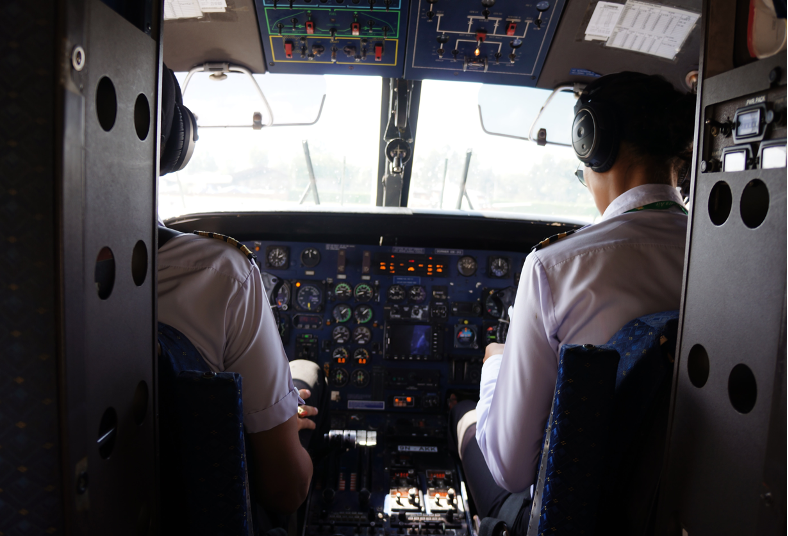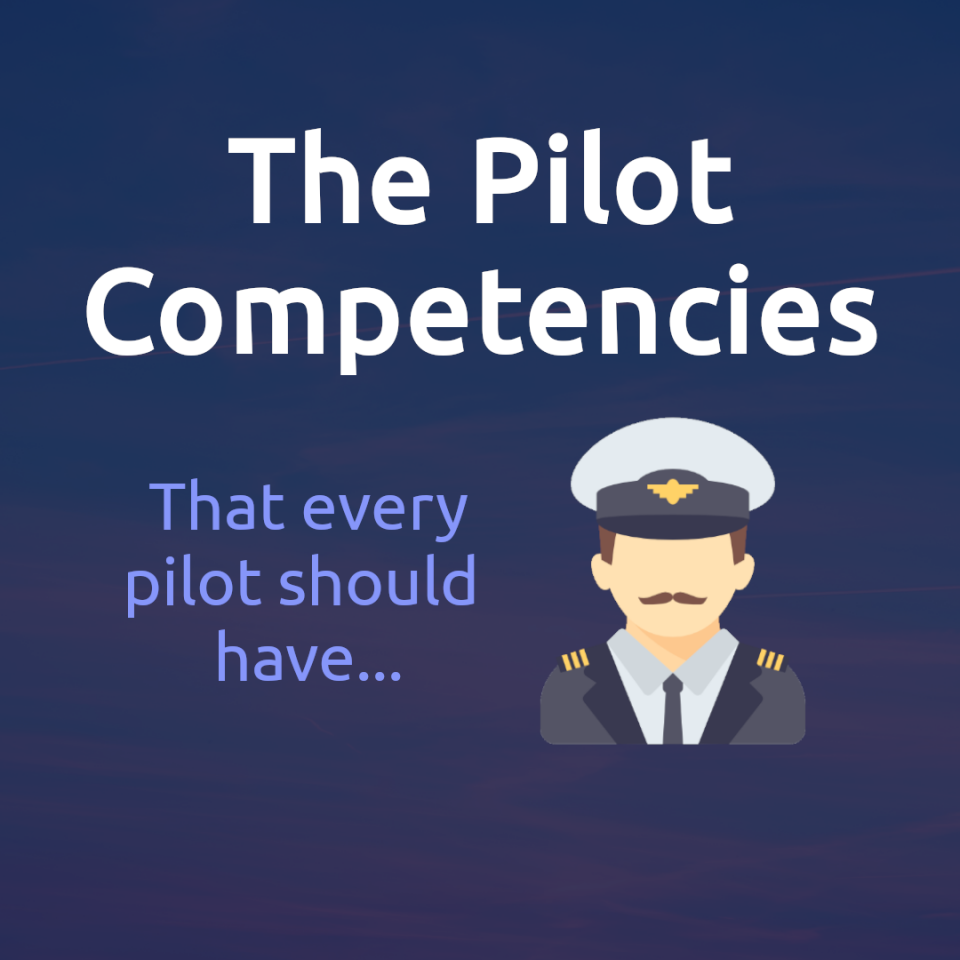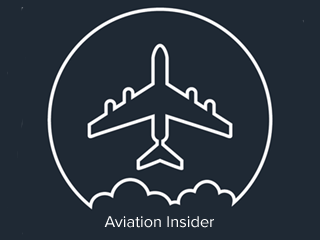PILOT COMPETENCIES
Being a pilot means being responsible for operating an aircraft and for people's lives, thus it is vital that core competencies are possessed right from the start, in order to facilitate safe and efficient operations. Airlines will assess you based on these competencies and skills during the selection process and any subsequent check flights. We have listed the key competencies below, which are both technical and non-technical and will enable pilots to carry out their duties to the best of their ability, safely and effectively. Most, if not all, of these competencies tie in with each other and so you will notice that they share similar key points.
COMMUNICATION
- Foster an open atmosphere for communication.
- Be clear and concise in what you wish to convey and try not to deviate from your point.
- Cross check one another to maintain reliability and accuracy.
- Back-up your suggestions with reasonable facts and information.
- Ensure you actively listen to what the other person/people are saying and process this information.
- Positive, open body language and eye contact. Around 75% of communication is via body language. Good non-verbal communication is vital.
- Ask for constructive feedback and don't be afraid to ask questions.
- Vocalise serious actions so that the others involved know what you are doing and can prevent any possible mistakes.
- Update your company, crew, ATC and airline ground handling if there are any significant changes.
- Communicate with your passengers and share with them any information you deem will be useful or of importance to them.
- Gain clarity on any conflicting information and ascertain the correct one/ones.
- Adhere to the standardised RT (Radio Telephony), which for the UK CAA can be found in CAP413.
TEAMWORK
- Work together to achieve a common goal.
- Communicate effectively and promote open discussion and participation.
- Know and utilise each other's experiences and skill levels.
- Identify each other’s strengths and weaknesses. Seek to build on strengths and improve any weaknesses. Recognise any team members/colleagues who are struggling and offer your assistance.
- Share tasks so that no-one is overloaded. This is part of effective workload management.
- Include all parties involved so that everyone is on the same page.
- Remain unbiased while listening to others views and opinions.
- Not competing with or treading on others is important. Be polite, professional and practice good reasoning.

LEADERSHIP & EFFECTIVE MANAGEMENT
- Lead by example in what you do and volunteer your assistance wherever necessary.
- Take responsibility for your actions and decisions.
- Delegate tasks so that you don’t become overwhelmed.
- Anticipate what the other person is going to do so you are ready to act in case they make a mistake.
- Be assertive when the situation dictates, but not overpowering, and give clear instruction to your crew. Remember that as the leader, you have the ultimate jurisdiction and sometimes it is necessary to have the final say.
- Actively encourage feedback from your colleagues and involve them in tasks and discussions.
- Be commercially aware, after all, if you are a commercial pilot, the business side of things is crucial as well.
- Use your initiative to deal with situations and find the safest and most effective ways to operate, while of course adhering to SOPs.
- Show empathy towards your colleagues and identify if something is wrong or just doesn't feel right.
- Resolve any conflicts in a calm, collected and sensible manner.
SITUATIONAL AWARENESS
- Effective threat and error management (TEM). Identify and protect.
- Ask yourself “what is next?” and be ahead of the aircraft and plan, especially during low workload periods. Good anticipation is key.
- Know what your endurance is, such as time, fuel and if there are any restrictions due to abnormalities.
- Recognise any loss of SA and work to resolve it.
- Be aware of all team members involved and implications which may be on them.
- Share mental models so there is harmonisation in understanding what is happening at present and what your thought processes are for any further plans.
- Be aware of the current aircraft state and operations, such as the current flight path, internal and external environment and aircraft systems.
AIRCRAFT MANAGEMENT - MANUAL
- Adopt smooth and accurate controlling of the aircraft.
- Manage your flight path effectively to ensure the highest safety and efficiency so that operational performance is kept to optimum levels.
- Ensure that the aircraft is flying as expected on all of its axes and trajectories.
- Keep monitoring all of the flight systems and if necessary, revert to levels of automation. Keep your scanflow active, such as speed, attitude, altitude, and identify any trends.
- Make certain at all times that your aircraft is operating within the safe flight envelope.
- Spot any deviations from your current flight path and take action where necessary. Share your mental model with your fellow crew members to mitigate any potential errors.
AIRCRAFT MANAGEMENT - AUTOMATION
- Have sufficient knowledge of your aircrafts automation systems, controls and limitations.
- Know your Flight Mode Annunciations (FMAs) and what they are telling you.
- Select the most appropriate level of automation for phase of flight and workload.
- If things aren't going to plan, or the automation is being a hindrance, be confident enough to recognise this and disconnect to revert to manual flight, either fully or in stages.
- Constantly monitor the automation and encompass it into your situational awareness.
- Treat your autopilot like an additional crew member.
- Detect any variations or deviations from what you deem should be happening at that time, communicate it with your other crew members to share your mental model and mitigate any potential errors.

WORKLOAD MANAGEMENT
- Aviate . Navigate . Communicate
- Prioritise tasks by phase of flight and level of urgency. Don’t get distracted by less important or irrelevant items.
- Know your procedures and systems so that you are ahead of the situation.
- Have effective time management when carrying out duties and tasks.
- Be able to identify stress and overloading in themselves and communicate it to other crew members and use levels of automation if needed.
- Cross check actions and maintain active monitoring and regular reviewing of them to ensure everything is going to plan.
- Use all available equipment and resources to aid better decision making and operations.
- Don't be afraid or reluctant to accept help or assistance. Keep in mind that you are working as a team to achieve the common goal of a safe and efficient flight.
- Focus on managing tasks in a structured and coordinated manner and not act erratically or on impulse.
PROBLEM SOLVING AND DECISION MAKING
- Keep a clear mind, act in a calm and collected manner and not act hastily so you correctly diagnose the situation and find the best resolve.
- Use an effective decision making model such as T-DODAR or PIOSEE.
- Be time conscious during the whole process.
- Use all available resources and aids, such as your knowledge, consulting other crew members, analysing aircraft systems and liaising with ground personnel.
- Open active discussion and always ask the question “Why?” and “What If?”
- Balance the pros and cons of your proposed actions/options.
- Keep reviewing the decisions made and their impacts, and show flexibility to change them if needed.
- Try to see the bigger picture as well as the small details so you gain a comprehensive perspective of the situation.
- Try to act without emotional influence or bias, and take an objective look at the situation to aid better judgement. Use facts, figures and behaviour.
RESILIENCE
- Ability to demonstrate resolve and recover mentally after things don't go to plan. Always keep in mind ‘Aviate, Navigate, Communicate.
- Remain calm in tough situations and don’t rush or panic.
- Identify where things went wrong, learn from it, improve and come back stronger. Know who and where your sources of support are.
- Have a healthy level of self-belief and back yourself in situations. Be positive in what you do and show conviction.
- Be self-aware and know where your limitations are so that you can identify it and improve.
- Help others who may be struggling and seek to extend a helping hand.
- Keep spare capacity so that you are not overburdened or overwhelmed.
- Not get locked in by the ‘startle effect’. Recognise this in others as well and help them by alleviating the load.
KNOWLEDGE AND APPLICATION OF SOPS
- Know your SOPs and the order of flow.
- Ensure that your checklist responses are accurate and ensure that you actively confirm that the actions have been completed. Don't just “parrott” the response.
- Be able to attain the required information to operate your flight and interpret them accurately, such as weather, notams, clearances, special information etc.
- Show practical knowledge of your aircraft systems, and what the limitations are, such as speeds, manoeuvrability, temperatures, quantities etc.
- Be disciplined in your practices and avoid taking shortcuts when it comes to safety and procedures.
- Be vigilant at all times and don’t allow your concentration to lapse, especially during periods of low stimulation such as the cruise.
- Familiarise yourself with the QRH/abnormal checklist so that in the event of abnormal situations, you are ready to act accordingly without worrying about where the event items are.
- Be timely in your application of procedures. Don't be too quick or too slow.
- Discipline yourself to comply with instructions, but also know when to deviate from SOPs when safety dictates.
As you can see, there are a multitude of competencies and skills which are required of pilots, especially airline pilots and adopting these will surely put you in good stead for your flying career and also in everyday life.
The Pilot | Network Team



